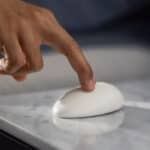Medical Disclaimer: The following content should not be used as medical advice or as a recommendation for any specific supplement or medication. It is important to consult your health care provider prior to starting a new medication or altering your current treatment.
The term micrognathia refers to an unusually small lower jaw. Micrognathia can occur alone to mildly affect the way a person looks by creating an overbite. Micrognathia can also occur as part of other medical conditions and accompany different facial features, like a mouth that is too small for the tongue.
When a small mouth and micrognathia happen together, the tongue obstructs the upper airway, making it hard to breathe. People with micrognathia who have issues breathing also have greater chances of developing sleep-related breathing disorders, including obstructive sleep apnea (OSA).
What Is Micrognathia?
Micrognathia, one of the most common facial irregularities, occurs when the lower jaw grows too slowly. Around one-third of people with micrognathia also have signs or symptoms of a genetic syndrome. A genetic syndrome is a group of medical conditions that occur together because of a mutation or change in a person’s DNA.
In people with micrognathia, a small mouth often occurs alongside an underdeveloped jaw. Without room for the tongue to sit properly in the mouth, the tongue may slide into the back of the throat. The irregular position of the tongue can block the upper airway and lead to sleep-related breathing disorders.
Micrognathia in Children
Micrognathia affects children of all ages, from newborns to older children. Among older children, micrognathia mainly causes problems with appearance. But in newborns, micrognathia can also cause serious problems with breathing. And all children with micrognathia have a greater risk of obstructive sleep apnea.
When a child with micrognathia rests on their back, their tongue tends to rest in the back of the throat and block the airflow. The irregular position of the tongue makes it difficult for newborns with micrognathia to breathe and feed properly.
Newborns with underdeveloped jaws may need to use a feeding tube or special nipples on their bottles, and they may require surgery to help them eat.
Micrognathia may cause breathing difficulty and blue skin, a sign of poor oxygen levels in the blood. If you have a child with micrognathia who has trouble breathing, contact a health care provider or call 911 immediately if they:
- Turn blue or pale
- Cave their chest inward with each breathe
- Flare or widen their nostrils
- Grunt or wheeze
- Breathe quickly, more than one breath per second
- Hunch forward or go limp
- Change mood or become lethargic
Some children with micrognathia outgrow the condition as they get older and their jawbones lengthen.
Micrognathia in Adults
By adulthood, some people born with micrognathia develop average-sized jaws. But those who still have underdeveloped jaws can have health problems related to the condition. Adults with micrognathia may have dental problems because the lower jaw does not lengthen enough to provide space for the adult teeth, which become crowded or misaligned.
The Link Between Obstructive Sleep Apnea and Micrognathia
People born with micrognathia have shorter jawbones, creating a narrow airway and making it harder to breathe while sleeping. Along with limited space for the tongue to sit in the mouth, the narrow airway constricts airflow during the night, leading to an increased risk of developing obstructive sleep apnea.
Micrognathia and Sleep Apnea in Children
Sleep apnea is generally rare in children, affecting only 1% to 5%. But the presence of micrognathia greatly increases the risk for breathing disorders. Up to 88% of children with micrognathia show signs of obstructive sleep apnea, in which a blocked airway repeatedly pauses breathing while a person sleeps.
Smaller jaw size has been associated with neuromuscular conditions that lead to nerve damage and muscle weakness. This combination of micrognathia and weakened muscles in the mouth and throat make breathing more difficult.
Children with micrognathia may overwork the upper airway muscles, causing the windpipe to collapse. This can lead to sleep-related breathing issues like obstructive sleep apnea.
Symptoms of OSA in children include:
- Snoring and noisy breathing
- Mouth breathing
- Wetting the bed
- Restless sleep
- Sweating during sleep
- Gasping coughing, or choking while asleep
Untreated OSA in children can lead to learning difficulties, behavioral problems, and slower growth rates. If your child has difficulty breathing at night, talk with your health care provider about the signs and symptoms of obstructive sleep apnea.
Micrognathia and Sleep Apnea in Adults
Obstructive sleep apnea occurs in 10% to 30% of adults. But adults with micrognathia have an increased risk of developing OSA because their shorter jaw length causes more breathing issues. Adults with OSA may snore loudly, have trouble falling asleep or staying asleep, and feel excessively tired during the day.
Untreated OSA may lead to poor work performance, lower quality of life, and a higher risk of car accidents. And untreated OSA increases the risk of developing other health conditions, including:
- High blood pressure
- Stroke
- Type 2 diabetes
- Depression
- Congestive heart failure
- Cardiac arrhythmias
Causes of Micrognathia
Micrognathia may occur for many reasons, including inherited genetic differences and developmental problems in the womb that prevent the growth of the jawbone. Injuries to the facial joint and medical treatments such as radiation and surgery can also lead to a small lower jaw.
Micrognathia can be isolated, but often appears along with other physical features as part of a syndrome. In fact, micrognathia is associated with more than 700 genetic syndromes that result from changes in a person’s DNA.
Other potential causes for micrognathia can include musculoskeletal conditions affecting the bones and joints or connective tissue disorders that affect the skin, eyes, and blood vessels. In some cases, the reason for the limited growth of the lower jaw is unknown.
Micrognathia and Pierre Robin Syndrome
When micrognathia appears with a tongue at the back of the throat and a high arch at the top of the mouth, doctors may diagnose Pierre Robin syndrome. This syndrome usually develops before the ninth week of pregnancy. In Pierre Robin syndrome, the small jawbone makes the tongue move backwards, stopping the roof of the mouth from fusing and creating a cleft palate.
The cause of Pierre Robin syndrome is not known, but it could be due to genetic disorders, lack of fluid around the baby, muscle issues, or problems with connective tissue. Sometimes Pierre Robin sequence happens by itself, but in other cases it’s part of a syndrome with additional birth disorders.
Some experts suggest that babies and children with Pierre Robin syndrome should be screened for sleep-related breathing disorders like obstructive sleep apnea. But as their facial bones grow longer during the first year, many babies with Pierre Robin syndrome experience fewer breathing difficulties.
Micrognathia Diagnosis
Micrognathia is typically diagnosed through a prenatal ultrasound conducted during the second trimester, which is between the 13th and 28th week of pregnancy. But doctors may also notice the condition in infancy, since newborns with micrognathia often struggle to breathe and feed normally.
Some babies with micrognathia have additional abnormalities associated with genetic syndromes and need genetic testing. Genetic testing identifies the exact differences in a child’s DNA, helping doctors diagnose specific genetic syndromes and provide more comprehensive medical care.
Micrognathia and Sleep Apnea Diagnosis
Diagnosis of obstructive sleep apnea for adults and children with micrognathia includes a sleep study or polysomnography. The sleep study is a test performed in a special laboratory or with a sleep test at home. Sleep specialists measure functions such as breathing rate, blood oxygen levels, and brain waves.
A sleep study also records the number of times a person stops breathing during sleep. The specialist uses this number to determine the person’s apnea-hypopnea index (AHI). Adults with an AHI greater than five and children with an AHI greater than one typically have obstructive sleep apnea.
Treating Micrognathia
Treating micrognathia can improve obstructive sleep apnea by lengthening the jawbone and giving the tongue more space to rest inside the mouth.
- Distraction osteogenesis: This procedure involves lengthening the lower jaw by placing a separator between two sections of the jawbone. New bone grows between the sections to make the lower jawbone longer, helping the jaw work better.
- Maxillomandibular advancement (MMA): MMA surgery reshapes the upper and lower jaw to pull the jawbone forward. The advancement of the lower jawbone can provide some people with micrognathia permanent relief from OSA symptoms.
- Tongue-lip adhesion (TLA): While the TLA procedure does not directly treat micrognathia, the operation prevents the tongue from blocking the upper airway. TLA surgery attaches the tongue to the lower lip or gums to prevent it from falling back into the mouth and throat.
- Nasopharyngeal airway (NPA): A nasopharyngeal airway or tracheotomy may work for children who have symptoms despite sleeping on their stomachs. During the NPA procedure, a small plastic tube separates the tongue and the back of the airway to improve breathing.
Micrognathia and Sleep Apnea Treatments
Although many obstructive sleep apnea treatments aim to keep the airway from becoming blocked, the treatments do not directly correct micrognathia. The most effective method to treat obstructive sleep apnea with micrognathia is positive airway pressure (PAP) therapy.
Continuous positive airway pressure (CPAP) and auto-titrating positive airway pressure (APAP) are the most common treatment options for OSA. These devices deliver pressurized air through a tube and into a sleeping person’s nose or mouth through a mask. The flow of air thro the mask keeps the airway from becoming blocked during the night.
Other treatment options for people with obstructive sleep apnea also help keep the upper airway from collapsing during sleep. Alternative treatments for obstructive sleep apnea include:
- Dental appliances
- Lifestyle changes like sleep hygiene and sleep positions
- Weight loss
- Surgery
If you have obstructive sleep apnea, speak to your health care provider about the treatment options best suited to your individual needs.
References
The Sleep Doctor Forum: Real Experiences, Real Connections
Continue the discussion on the Sleep Doctor Forum. Connect with experts and fellow forum members on CPAP, sleep apnea, and all things sleep. A priceless resource that’s free to join.









































